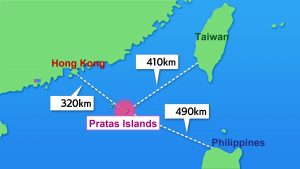By Yoshiyuki Ogasawara

As China’s military intimidation of Taiwan intensifies, experts are increasingly warning of a possible Chinese attack and the potential danger in the Taiwan Strait. Considering the language Chinese media use regarding measures to “punish Taiwan,” there is now an urgent need to consider China’s possible engagement in some sort of military action against Taiwan.
At present, it is improbable that the PLA would attempt to actually land troops and occupy the island of Taiwan, because the probability of a successful military operation with minimum casualties for China is low. However, China has other options, one of which would be to apply pressure on or capture the Pratas Islands.
The Pratas Islands are located in the northern part of the South China Sea under the jurisdiction of the Republic of China (Taiwan), closer to China’s mainland coast than to the island of Taiwan. Historically, the Pratas Islands have attracted little attention, but as the importance of the South China Sea has increased, so too has the strategic relevance of the Pratas Islands. If China controlled the Pratas Islands, the islands could function as a gatekeeper to monitor U.S. and other countries’ ships and aircraft entering the South China Sea from the Pacific Ocean.
Pratas Island (the other “islands” in the group are essentially rocks) has an airport, but no permanent inhabitants, only a number of civil officials of the Taiwanese Coast Guard and researchers. It is believed that around 500 soldiers of the ROC Marine Corps are also now stationed there. However, because the island is so small and flat, it is almost impossible to defend.
Since August, there have been reports of the PLA repeatedly conducting military exercises in the area, its aircraft flying over the sea almost daily in an apparent attempt to cut off the supply line between the Pratas Islands and the island of Taiwan.
In October, a Taiwanese airplane flying from Kaohsiung carrying supplies to the Pratas Islands was warned by Hong Kong air traffic control not to enter Hong Kong managed airspace and returned to Taiwan. These incidents demonstrate that China could take control of the Pratas Islands whenever Chinese President Xi Jinping decides.
That would offer numerous benefits to China: (1) It would demonstrate China’s will and capabilities to Taiwan and other neighboring countries. (2) China could militarize the island as a step toward internalizing the entire South China Sea. (3) It would disrupt the early days of the Biden administration by retaking the initiative from the United States after four years of endurance under President Donald Trump. (4) Xi has been in office for eight years now, but the unification of Taiwan is no closer. The capture of the Pratas Islands might serve to cover this “inconvenient truth” and could be used to play up the propaganda war that “unification is approaching” both at home and abroad.
As for taking control of the Pratas Islands, China has plenty of options. It could conduct a surprise landing operation, forcing the Taiwanese garrison to surrender. It could blockade the islands by air and sea to exhaust Taiwanese soldiers. Alternatively, it could simply make a preliminary declaration of an attack or blockade, in a bid to force the Taiwanese garrison to retreat. For a longer term approach, it could use acts of tacit interference against Taiwanese ships and aircraft to paralyze the supply line. Or it could normalize military exercises around the islands to create psychological pressure on the Taiwanese people.
For Xi, who will preside over the centennial anniversary of the CCP in 2021 and the Twentieth Party Congress in 2022, and who envisages an extension of his term of office, it might be desirable and even necessary to show some “progress” toward the unification of Taiwan.
Recent opinion surveys show rising anti-China sentiment in the United States, Japan and other democratic countries. Any attack on Taiwan now would surely prompt an outcry in these countries. Xi is surely aware of the damage to China’s reputation that military action would cause.
But the Pratas Islands, might be different given that few people outside the immediate region have heard of them. The Chinese leadership may calculate that the international reaction to the capture of the Pratas Islands would not be as intense as that which would inevitably follow an attack on Taiwan itself. Moreover, China could experiment with the various options noted above.
For instance, while monitoring the response in Washington, China could start with the stepped-up military exercises, before moving to supply line disruptions. If that met with only a muted reaction from the Biden Administration, China could escalate. If the U.S. response was more robust, China could avoid further escalation and continue to exert pressure on Taiwan with supply line interference. If this were to create a panic and feeling of resignation in Taiwan, it would be a windfall for Xi.
In capturing the Pratas Islands, China could kill several birds with one stone. For instance, success could serve to consolidate Xi’s grip on the CCP. As such, the islands are a potential flashpoint that now need to come to the attention of the U.S., Japan and other democratic countries.
Yoshiyuki Ogasawara is a professor at the Graduate School of Global Studies, Tokyo University of Foreign Studies.
No comments:
Post a Comment